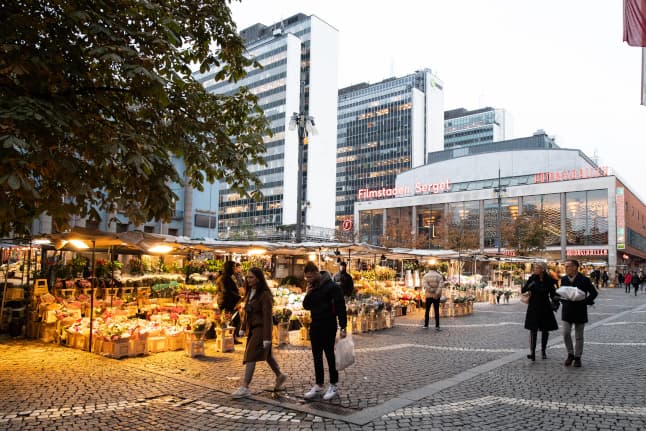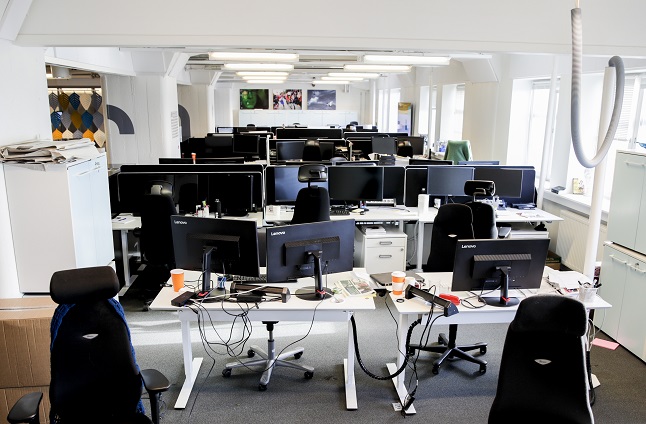EXPLAINED: What does Sweden's new limit on public events actually mean?

UPDATED: Public gatherings with more than eight people are now prohibited, after a considerable tightening of coronavirus measures. But when exactly do these new regulations apply?
What's happened?
Sweden on Monday announced a ban on public events of more than eight people, which is set to come into place on November 24th and initially last for four weeks.
Previously the limit has mostly been set at 50 since March. This was raised to 300 for specific events in late October, but all of Sweden's regions chose to keep the stricter limit of 50. That limit of 50 remains in place for certain seated events for now as these aren't covered by the latest change, and it will be up to regions to decide whether to lower it to eight.
How strict is the ban?
Unlike many of Sweden's coronavirus measures, this is a law change and not a recommendation. It forms part of the Public Order Act, so the police will be able to cancel or end public events that are in violation of the ban.
Organisers can be fined or receive a prison sentence for a maximum of six months.
What exactly is a 'public event'?
The ban applies to events that require an application for a permit from the police. These are public gatherings and events aimed at the general public, including for example theatre performances, demonstrations, lectures, concerts, and sports events.
Prime Minister Stefan Löfven was very clear that the limit of eight people should also set a "norm" for private gatherings too, urging people to cancel dinners, parties and trips to gyms or libraries, but these kinds of gatherings are not regulated by the Public Order Act.
Which gatherings are not covered?
Private events such as parties or corporate events – events not open to the public – are not formally included in the regulation.
This category also includes gyms, swimming pools, libraries, restaurants, schools, public transport, squares, shopping centres and so on.
However, most Swedish regions now have recommendations in place which ask everyone to refrain from close contact with people they don't live with and non-essential visits to indoor environments like shops, gyms, and museums. At Monday's press conference, ministers urged people to follow these recommendations and not to look for loopholes or justifications to continue these activities.

An almost empty Stockholm central station. Photo: Amir Nabizadeh/TT
Why aren't private gatherings covered by the law change?
This is partly down to Sweden's constitution, which in its current form doesn't allow for limits on the number of people who meet privately.
It's also due to practicality, with both Prime Minister Stefan Löfven and Health Minister Lena Hallengren saying "it's not possible to legislate common sense".
The argument from Swedish authorities throughout the pandemic has been that it is better to explain the actions people need to take and have them make these changes voluntarily rather than through complex legislation. Since April, everyone in Sweden has been urged to limit their social contacts and keep a distance from others in public places. Over recent weeks, stricter recommendations have been introduced in all but one region, generally requiring the public to avoid socialising with people they don't live with.
However, Hallengren noted that "behaviour has not yet changed enough to turn the direction of the development".
What about restaurants and bars?
These are not covered by the limit of eight, so restaurants may have more than eight people in total, but as of early November restaurants and bars are covered by separate rules which mean no more than eight people may be seated at one table. They should also ensure a 1.5-metre distance between tables and offer table service only.
Restaurants will however effectively not be allowed to organise for example music performances, as these would then fall under the ban on public events of more than eight people.
The government also proposed a ban on serving alcohol at cafes and pubs after 10pm. The ban is intended to take effect on November 20th and will be in place until the end of February.
What about workplaces?
Workplaces are not directly affected by the new ban, but the recommendation issued by the Swedish Public Health Agency is that everyone who can should work from home as much as possible, at least until the end of the year. That recommendation still applies.

Photo: Vidar Ruud/NTB scanpix/TT
What about face masks?
There is still no law or recommendation to wear face masks in any situation outside the health and social care sector, although individual businesses may have their own requirements.
Responding to a question from Aftonbladet on the subject, Prime Minister Stefan Löfven pointed out there is no recommendation against wearing masks, while Public Health Agency director Johan Carlson said the agency was focusing on preventing crowded situations rather than advising masks in these situations.
Neither responded directly to the journalist's question about whether it was necessary to advise wearing masks in situations where crowding cannot reasonably be avoided, for example on public transport when commuting to work that cannot be done from home.
Wasn't the limit on public events recently raised?
Yes, for some kinds of events only. Since March, Sweden has had a ban on public events for more than 50 people, but on October 22nd, the government announced that it had decided to raise this limit in the case of certain events.
For theatre, concerts, cinemas and sports events where the audience would be assigned designated seats, the maximum limit was raised to 300 people, given that the necessary distance between people could be ensured, curbing the risk of infection. This measure took effect on November 1st.
The exception remains in place, but in practice it has little significance as all regions have decided to stick to the lower maximum of 50 people. This is not directly affected by the new limit of eight, but it is possible regions will apply this new lower limit to seated events too.
What do the new restrictions mean for Christmas celebrations?
This is not yet clear. The current law change is set to last for at least four weeks from November 24th, which means it would expire on December 23rd.
However, Interior Minister Mikael Damberg was clear that if the coronavirus situation required it, the law could remain in place longer, and Public Health Agency head Johan Carlson said the agency would make its Christmas recommendations public in early December.
"We are coming into a new season, the season for winter tourism and travel, visits to friends and family over Christmas, school holidays and so on. We intend to come out with new recommendations ahead of Christmas, in good time, and give a clear picture. On one hand we want to do this early, on the other hand we want to leave it long enough that the restrictions are appropriate at the time," he said.
Is there a ban on visiting elderly care homes throughout the country?
No. The national ban was lifted earlier in the autumn, but could be reintroduced if deemed necessary, the government states.
However, a visiting ban has been introduced in certain elderly care homes, for example in Stockholm, with the support of the Social Services Act.
Editor's note: We have updated the article after the Justice Ministry clarified details about the exception for seated events to the TT newswire.
Comments
See Also
What's happened?
Sweden on Monday announced a ban on public events of more than eight people, which is set to come into place on November 24th and initially last for four weeks.
Previously the limit has mostly been set at 50 since March. This was raised to 300 for specific events in late October, but all of Sweden's regions chose to keep the stricter limit of 50. That limit of 50 remains in place for certain seated events for now as these aren't covered by the latest change, and it will be up to regions to decide whether to lower it to eight.
How strict is the ban?
Unlike many of Sweden's coronavirus measures, this is a law change and not a recommendation. It forms part of the Public Order Act, so the police will be able to cancel or end public events that are in violation of the ban.
Organisers can be fined or receive a prison sentence for a maximum of six months.
What exactly is a 'public event'?
The ban applies to events that require an application for a permit from the police. These are public gatherings and events aimed at the general public, including for example theatre performances, demonstrations, lectures, concerts, and sports events.
Prime Minister Stefan Löfven was very clear that the limit of eight people should also set a "norm" for private gatherings too, urging people to cancel dinners, parties and trips to gyms or libraries, but these kinds of gatherings are not regulated by the Public Order Act.
Which gatherings are not covered?
Private events such as parties or corporate events – events not open to the public – are not formally included in the regulation.
This category also includes gyms, swimming pools, libraries, restaurants, schools, public transport, squares, shopping centres and so on.
However, most Swedish regions now have recommendations in place which ask everyone to refrain from close contact with people they don't live with and non-essential visits to indoor environments like shops, gyms, and museums. At Monday's press conference, ministers urged people to follow these recommendations and not to look for loopholes or justifications to continue these activities.

An almost empty Stockholm central station. Photo: Amir Nabizadeh/TT
Why aren't private gatherings covered by the law change?
This is partly down to Sweden's constitution, which in its current form doesn't allow for limits on the number of people who meet privately.
It's also due to practicality, with both Prime Minister Stefan Löfven and Health Minister Lena Hallengren saying "it's not possible to legislate common sense".
The argument from Swedish authorities throughout the pandemic has been that it is better to explain the actions people need to take and have them make these changes voluntarily rather than through complex legislation. Since April, everyone in Sweden has been urged to limit their social contacts and keep a distance from others in public places. Over recent weeks, stricter recommendations have been introduced in all but one region, generally requiring the public to avoid socialising with people they don't live with.
However, Hallengren noted that "behaviour has not yet changed enough to turn the direction of the development".
What about restaurants and bars?
These are not covered by the limit of eight, so restaurants may have more than eight people in total, but as of early November restaurants and bars are covered by separate rules which mean no more than eight people may be seated at one table. They should also ensure a 1.5-metre distance between tables and offer table service only.
Restaurants will however effectively not be allowed to organise for example music performances, as these would then fall under the ban on public events of more than eight people.
The government also proposed a ban on serving alcohol at cafes and pubs after 10pm. The ban is intended to take effect on November 20th and will be in place until the end of February.
What about workplaces?
Workplaces are not directly affected by the new ban, but the recommendation issued by the Swedish Public Health Agency is that everyone who can should work from home as much as possible, at least until the end of the year. That recommendation still applies.

Photo: Vidar Ruud/NTB scanpix/TT
What about face masks?
There is still no law or recommendation to wear face masks in any situation outside the health and social care sector, although individual businesses may have their own requirements.
Responding to a question from Aftonbladet on the subject, Prime Minister Stefan Löfven pointed out there is no recommendation against wearing masks, while Public Health Agency director Johan Carlson said the agency was focusing on preventing crowded situations rather than advising masks in these situations.
Neither responded directly to the journalist's question about whether it was necessary to advise wearing masks in situations where crowding cannot reasonably be avoided, for example on public transport when commuting to work that cannot be done from home.
Wasn't the limit on public events recently raised?
Yes, for some kinds of events only. Since March, Sweden has had a ban on public events for more than 50 people, but on October 22nd, the government announced that it had decided to raise this limit in the case of certain events.
For theatre, concerts, cinemas and sports events where the audience would be assigned designated seats, the maximum limit was raised to 300 people, given that the necessary distance between people could be ensured, curbing the risk of infection. This measure took effect on November 1st.
The exception remains in place, but in practice it has little significance as all regions have decided to stick to the lower maximum of 50 people. This is not directly affected by the new limit of eight, but it is possible regions will apply this new lower limit to seated events too.
What do the new restrictions mean for Christmas celebrations?
This is not yet clear. The current law change is set to last for at least four weeks from November 24th, which means it would expire on December 23rd.
However, Interior Minister Mikael Damberg was clear that if the coronavirus situation required it, the law could remain in place longer, and Public Health Agency head Johan Carlson said the agency would make its Christmas recommendations public in early December.
"We are coming into a new season, the season for winter tourism and travel, visits to friends and family over Christmas, school holidays and so on. We intend to come out with new recommendations ahead of Christmas, in good time, and give a clear picture. On one hand we want to do this early, on the other hand we want to leave it long enough that the restrictions are appropriate at the time," he said.
Is there a ban on visiting elderly care homes throughout the country?
No. The national ban was lifted earlier in the autumn, but could be reintroduced if deemed necessary, the government states.
However, a visiting ban has been introduced in certain elderly care homes, for example in Stockholm, with the support of the Social Services Act.
Editor's note: We have updated the article after the Justice Ministry clarified details about the exception for seated events to the TT newswire.
Join the conversation in our comments section below. Share your own views and experience and if you have a question or suggestion for our journalists then email us at [email protected].
Please keep comments civil, constructive and on topic – and make sure to read our terms of use before getting involved.
Please log in here to leave a comment.